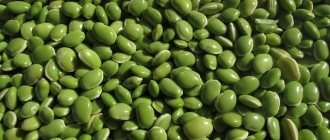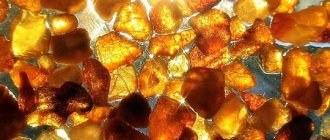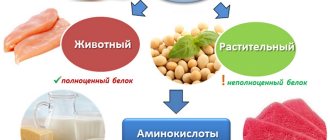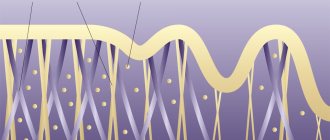ALANIN
Properties:
- nonessential amino acid
- an important source of energy for the brain and central nervous system
- strengthens the immune system by producing antibodies
- actively participates in the metabolism of sugars and organic acids, an important source of energy and a regulator of blood sugar levels.
Signs of excess alanine:
- a feeling of fatigue that does not go away after 12 hours of rest
- decreased memory and ability to concentrate
- sleep problems
- depression
- muscle pain
- joint pain
Signs of alanine deficiency:
- increased fatigue, nervousness and depression
- hypoglycemia (low blood sugar)
- urolithiasis disease
- reduced immunity, frequent viral diseases
- decreased libido
- decreased appetite
Types of amino acids
All amino acids known today can be divided into two main types: nonessential and essential. As you probably already guessed, essential amino acids are those substances that cannot be synthesized by the body on its own and cannot be replaced by any other substances. That is why it is worth making sure that they regularly enter the body with food. As for non-essential amino acids, they can be obtained as a result of the synthesis of other nutrients during internal processes. Therefore, their use in pure form is not necessary. However, both amino acids are equally important for the body, so preference should not be given to any one type.
Nonessential amino acids
As mentioned earlier, non-essential amino acids are synthesized by the body during metabolism, extracted in sufficient quantities from other organic substances. When the need arises, that is, when amino acid reserves are depleted, the body automatically switches to the mode of creating the necessary amino acid. Essential amino acids include arginine, alanine, glutamine, glycine, tyrosine, proline, asparagine, serine and cysteine. Let's take a closer look at some of them and their effect on our body.
Alanin
This amino acid is produced by the body through meat, dairy products, fish, poultry, eggs and some plant foods such as avocados. Alanine is an excellent source of energy that provides the body with strength for a long period. It helps speed up the processing and absorption of glucose and removes toxins from the liver. In addition, alanine prevents the breakdown of muscle tissue, which occurs especially intensely during physical activity. In some cases, alanine acts as a prophylactic agent for prostate enlargement.
Arginine
An amino acid such as arginine is very important for humans and is considered one of the most important in the body. It takes part in maintaining healthy joints, muscles, skin and liver. It has restorative properties, so it often promotes tissue regeneration in arthritis and other joint diseases. Arginine is directly involved in the process of strengthening the immune system, participates in the synthesis of creatine, and also reduces the amount of body fat, which will be very useful for those who play sports to lose weight. Although arginine is produced by the body, people with burns on the skin and those who want to quickly gain muscle mass are recommended to additionally take this amino acid in the form of a dietary supplement. Natural sources of arginine include dairy products, meat, chocolate, some nuts, oats and wheat.
Glutamine
You can get this essential amino acid from many foods, especially greens. However, it is worth considering that glutamine is quickly destroyed during heat treatment, so its sources are best consumed raw. This amino acid is involved in creating muscles and maintaining their condition. It acts as a source of nutrition for the brain, and also represents a source of energy for the nervous system, normalizing its condition and relieving tension. In addition, glutamine can remove toxic substances from the liver, prevent unwanted breakdown of muscle tissue, strengthen the immune system and help with arthritis and chronic fatigue. In a word, this essential amino acid must be present in the diet of those who are concerned about their health.
Essential amino acids
Essential amino acids, or as they are also called, cannot be synthesized by our body, so practically their only source is the food we eat daily. If there is a shortage of these amino acids, the body consumes them from muscle tissue, which negatively affects the condition of the muscles. Essential amino acids include leucine, isoleucine, lysine, methionine, histidine, valine, threonine and tryptophan.
Leucine
This amino acid belongs to the BCAA class, as it has a branched chain and plays a very important role in the process of muscle recovery, making it incredibly popular among people who regularly exercise. Leucine is converted into glucose much faster than other essential amino acids, which helps stop catabolic processes in muscle tissue that occur during grueling workouts. In addition, leucine controls blood sugar levels, increases the production of growth hormone, and also promotes fat burning, which will certainly please those who have taken up sports for the purpose of losing weight. Sources of leucine include meat, nuts, legumes, rice, whole wheat and soy flour.
Isoleucine
Isoleucine, like the previous amino acid, is one of the main BCAA amino acids, which are often used in professional bodybuilding. Regular consumption of isoleucine helps increase endurance and training productivity, accelerates recovery and growth of muscle mass, stimulates the replenishment of energy reserves naturally, eliminating muscle destruction. Thanks to isoleucine, you can improve your athletic performance and achieve the desired shape in the shortest possible time. You can get this essential amino acid from meat, fish, nuts, eggs, peas, soy and seeds.
Lysine
This amino acid is often added to sports nutrition, since its main function is to strengthen the immune system, which weakens with a lack of nutrients and excessive stress on the body. Lysine has antiviral properties, it regulates bone tissue renewal processes, prevents the development of colds, and also stimulates the production of collagen and muscle protein, which contribute to the rapid recovery of the body and muscles in particular. In order to replenish lysine reserves, you need to eat red meat, fish, milk, eggs, cheese, potatoes and yeast.
Methionine
Among the essential amino acids that our body needs is methionine, which has unique properties. It takes part in the processing and utilization of fats, so it often helps during weight loss and is in demand among those who want to lose excess weight. This amino acid is involved in the formation of taurine and cysteine, which, in turn, remove toxic substances from the body, cleansing and renewing it. With the help of methionine, creatine is synthesized, which increases performance and endurance. Without it, the synthesis of collagen, which is responsible for the elasticity and firmness of the skin, as well as the health of the nails, is impossible. Methionine should become an integral part of the diet for people suffering from arthritis and allergies. You can get it from meat, fish, legumes, onions, garlic and soy.
LDC "Neuron"
- < Back
- Forward >
ARGININE
Properties:
- conditionally essential amino acid, after 30 years synthesis decreases
- normalizes metabolic processes in the body (reduces cholesterol)
- reduces intraocular pressure
- participates in the production of hormones and enzymes
- increases muscle mass, at the same time reduces the content of fatty tissue in the body, strengthens the framework of muscles and cartilage
- supports normal functioning of the nervous and immune systems
- improves sperm composition in men
- increases blood flow to the genitals in men and women, increases potency and libido, enhances sexual desire
- participates in the production of the hormone serotonin (the hormone of joy)
Signs of excess arginine:
- hives
- limb tremors
- irritability turning into aggressiveness
- lowering blood pressure
Signs of arginine deficiency:
- increased blood pressure
- brain disorder
- hormonal imbalances
- deterioration of sperm condition
- decreased libido
- premature aging
- obesity
Benefits of Taking Essential Amino Acid Supplements
While essential amino acids can be found in a wide range of foods, taking concentrated doses in supplement form is associated with several health benefits.
May help improve mood and sleep
Tryptophan is essential for the production of serotonin, a chemical that acts as a neurotransmitter in your body.
Serotonin is an important regulator of mood, sleep and behavior.
While low serotonin levels are associated with depressed mood and sleep disturbances, several studies have found that taking tryptophan supplements may reduce symptoms of depression, boost mood, and improve sleep (, , , , ).
A 19-day study of 60 older women found that 1 gram of tryptophan per day resulted in increased energy levels and improved happiness compared to placebo ().
Can improve performance in sports
The three essential branched chain amino acids are widely used to relieve fatigue, improve athletic performance, and promote muscle recovery after exercise.
In a study of 16 weightlifters, branched chain amino acids were found to improve muscle performance and recovery, and reduce muscle soreness compared to a placebo ().
A recent review of eight studies found that taking branched-chain amino acid supplements stimulated muscle recovery and reduced soreness after exhaustive exercise ().
Additionally, 4 grams of leucine per day for 12 weeks increased strength in untrained men, showing that essential amino acids may also benefit non-strength athletes ().
May prevent muscle loss
Loss of muscle mass is a common side effect of long-term illness and bed rest, especially in older adults.
Essential amino acids have been found to prevent muscle breakdown and maintain lean body mass.
A 10-day study of 22 older adults on bed rest found that those who received 15 grams of an essential amino acid mixture maintained muscle protein synthesis, while those receiving a placebo decreased muscle protein synthesis by 30% ().
Essential amino acid supplements have been found to be effective in maintaining lean body mass in older adults and athletes (, ).
May promote weight loss
Some human and animal studies have shown that branched chain essential amino acids may be effective in promoting the loss of body fat mass.
For example, an eight-week study of 36 strength-training men found that taking 14 grams of branched-chain amino acids per day significantly reduced body fat percentage compared to taking whey protein or sports drinks ().
A study in rats found that a diet supplemented with 4% leucine reduced body and fat mass ().
However, other studies examining the potential link between branched chain amino acids and weight loss have been inconsistent. More research is needed to determine whether these amino acids can promote weight loss (, ).
Conclusion:
Taking supplements of certain essential amino acids can help improve your mood, enhance exercise performance, prevent muscle loss, and promote weight loss.
ASPARAGIC ACID
Properties:
- nonessential amino acid
- strengthens the body and increases performance
- participates in the synthesis of immunoglobulins
- plays a vital role in metabolism
- speeds up recovery from fatigue
- Helps extract energy from complex carbohydrates
- deactivation of ammonia, helps the liver remove residual elements of chemicals and drugs from the body
- participates in the production of urea in the human body (binds ammonia and transfers it to the kidneys for subsequent excretion)
- helps potassium and magnesium ions penetrate into the cell
- increases testosterone production in the body and its release by the testicles
Signs of excess aspartic acid:
- overexcitation of the nervous system
- increased aggressiveness
- blood thickening
- increase testosterone, prolactin, growth hormone
- For pregnant women, consuming large amounts of foods containing aspartic acid can negatively affect the baby's nervous system, causing autism.
Signs of aspartic acid deficiency:
- memory impairment
- depression
- decreased performance
- decreased levels of testosterone, progesterone
- decreased libido
- decreased immunity
Where are they kept?
Essential amino acids are found in plant and animal foods:
- leucine – nuts, rice, fish, eggs;
- isoleucine – almonds, lentils, fish;
- valine – mushrooms, beans, meat, milk;
- phenylalanine – beef, eggs, cottage cheese, nuts;
- tryptophan – turkey, yogurt, beans, sesame, fish;
- threonine – nuts, milk, eggs;
- lysine – wheat, milk, fish;
- methionine – eggs, sesame seeds, rice, peanuts.
Rice.
3. Products containing essential amino acids. The body can function without essential amino acids. However, their deficiency leads to disruption of protein synthesis, which entails a decrease in mental abilities and immunity. Excess creates a load on the liver and kidneys.
GLYCINE
Properties:
- nonessential amino acid
- metabolic regulator
- normalizes the processes of excitation and inhibition in the central nervous system
- has an anti-stress effect
- increases mental performance.
Signs of excess glycine:
- hyperactivity
- rapid heartbeat
- various allergic reactions
- facial redness
- fatigue
Signs of glycine deficiency:
- increased nervous excitability
- bad dream
- trembling in the body
- weakness
- depression
GLUTAMIC ACID
Properties:
- conditionally essential amino acid, is a neurotransmitter transmitting impulses in the central nervous system
- participates in protein and carbon metabolism
- increases the body's resistance to hypoxia (oxygen starvation)
- neutralizes ammonia
- participates in the synthesis of nucleic acids
- glutamic acid can be converted into some essential amino acids, in particular histidine and arginine
- maintains natural hair color, elasticity and smoothness of the skin
Signs of excess glutamic acid:
- blood thickening
- headache
- decreased hemoglobin levels
- nausea
- liver dysfunction
- Alzheimer's disease
- decreased vision and glaucoma
- liver and kidney diseases
Signs of glutamic acid deficiency:
- disruption of the gastrointestinal tract
- early gray hair (before 30 years);
- problems with the central and autonomic nervous system
- skin aging
- memory loss, depressed mood
- weak immunity
- epileptic seizures
Beneficial properties of amino acids, their effect on the body
Each amino acid has its own effect on the body.
So methionine is especially important for improving fat metabolism in the body; it is used as a prevention of atherosclerosis, cirrhosis and fatty liver degeneration. For certain neuropsychiatric diseases, glutamine and aminobutyric acids are used. Glutamic acid is also used in cooking as a flavoring additive. Cysteine is indicated for eye diseases.
The three main amino acids - tryptophan, lysine and methionine, are especially necessary for our body. Tryptophan is used to accelerate the growth and development of the body, and it also maintains nitrogen balance in the body.
Lysine ensures normal growth of the body and participates in the processes of blood formation.
The main sources of lysine and methionine are cottage cheese, beef, and some types of fish (cod, pike perch, herring). Tryptophan is found in optimal quantities in offal, veal and game.
Interaction with Essential Elements
All amino acids are soluble in water. Interact with vitamins B, A, E, C and some microelements; participate in the formation of serotonin, melanin, adrenaline, norepinephrine and some other hormones.
Signs of deficiency and excess of amino acids
Signs of a lack of amino acids in the body:
- loss of appetite or decreased appetite;
- weakness, drowsiness;
- delayed growth and development;
- hair loss;
- deterioration of skin condition;
- anemia;
- weak resistance to infections.
Signs of excess of certain amino acids in the body:
- disorders of the thyroid gland, hypertension - occur with an excess of tyrosine;
- early gray hair, joint diseases, aortic aneurysm can be caused by an excess of the amino acid histidine in the body;
- methionine increases the risk of stroke and heart attack.
Such problems can only arise if there is a lack of vitamins B, A, E, C and selenium in the body. If these beneficial substances are contained in the right amount, excess amino acids are quickly neutralized, due to the conversion of excess into substances beneficial to the body.
Factors influencing the content of amino acids in the body
Nutrition, as well as human health, are the determining factors in the content of amino acids in the optimal ratio. Lack of certain enzymes, diabetes mellitus, and liver damage lead to uncontrolled levels of amino acids in the body.
Amino acids for health, energy and beauty
To successfully build muscle mass in bodybuilding, amino acid complexes consisting of leucine, isoleucine and valine are often used.
To maintain energy during training, athletes use methionine, glycine and arginine, or products containing them, as dietary supplements.
For any person leading an active healthy lifestyle, special foods are needed that contain a number of essential amino acids to maintain excellent physical shape, quickly restore strength, burn excess fat or build muscle mass.
We have collected the most important points about amino acids in this illustration and will be grateful if you share the picture on a social network or blog with a link to this page:
Attention! The information is for informational purposes only and is not intended to make a diagnosis or prescribe treatment. Always consult a specialized doctor!
Tatyana Eliseeva chief editor of the Food+ project
Ask a Question
Rating:
9.9
/10
Votes: 12
Usefulness of material 10
Reliability of information 10
Formatting of Article 9.8
VALINE
Properties:
- essential amino acid
- participates in the formation and restoration of muscle tissue
- is part of the elastin of all connective tissues of the human body
- normalizes nitrogen balance in the body
- participates in the synthesis of glial cells that protect nerve fibers
- improves the body's adaptation to cold and heat
- the main substance needed by the body for the biosynthesis of vitamin B5
- dulls the feeling of hunger
- promotes the synthesis of serotonin (the hormone of joy)
- improves coordination
Signs of excess valine:
- crawling sensations, numbness, tingling in the limbs
- problems with the gastrointestinal tract
- irritability
- allergic reactions.
Signs of valine deficiency:
- cracks in the mucous membranes
- arthritis and arthrosis
- memory impairment
- weakened immune system
- depressed mood
- light sleep
- muscular dystrophy (muscles become flabby, any tension causes pain)
- dry mucous membranes of the eyes
- temperature changes in the external environment cause a feeling of chills or heat (“I’m cold”, “I’m hot”)
Amino acids in sports nutrition
In sports nutrition, various types of amino acids are produced. By release form:
- In powder - the best price/effect ratio. Disadvantage: inconvenient to use
- In tablets - a more expensive option, but a more convenient form of use
- Capsules are the most expensive option. The high price of amino acids is explained here by better absorption.
- Liquid - after opening, it must be stored in the refrigerator for no more than 2-3 weeks.
Based on their composition, amino acid supplements are divided into:
- Complex - contains all essential and essential amino acids. Or just a few - the most popular BCAAs (consists of three essential amino acids - leucine, isoleucine and valine)
- Single - only one amino acid is produced. It can be either replaceable (the most popular is L-glutamine) or irreplaceable, for example, methionine or leucine.
METHIONINE
Properties:
- essential amino acid,
- detoxification of the body from heavy metals
- protecting the body from radiation
- protects against atherosclerosis
- protects the liver from excess fat
- activates hormones, vitamins and enzymes that have the property of neutralizing various toxins
Signs of excess methionine:
- allergic reactions;
- nausea and vomiting;
- feeling drowsy
Pregnant women, nursing mothers and women should not take methionine without consulting a doctor because methionine increases estrogen production.
Signs of methionine deficiency:
- liver damage
- swelling
- hair fragility
- slow development of the fetus and newborn
- malformations of the nervous system in children
- severe mental disorders
- development of atherosclerosis
ORNITINE
Properties:
- a nonessential amino acid that is present and synthesized in the human body
- ornithine has the property of being converted to arginine
- stimulates the secretion of growth hormone
- stimulates insulin synthesis
- protects the liver from the toxic effects of various foods and pharmacological drugs, restores liver cells
- removes ammonia from the body
- improves the functioning of the immune system
- promotes rapid healing of wounds
Natural proteinogenic amino acids
The total number of amino acids in nature is about 300, in the human body - more than 60. However, the number of amino acids from which protein synthesis occurs is only about 20 (sometimes there are 21-22), and they are called proteinogenic amino acids, or natural. From them, in the process of protein synthesis and the formation of its structure, other amino acids are formed. These natural 20 amino acids are programmed in the genetic code of any organism, from a virus to a person, and it is their sequence in the protein molecule chain that determines the uniqueness of all forms of life on Earth.
In human organs and tissues, the main role of these compounds is participation in protein synthesis, which takes up the vast majority of all received or formed amino acids. But there are also individual amino acids that have independent functions. Thus, tyrosine is responsible for the coloring of hair, skin, eyes, and gives a dark color to food products, for example, rye bread, since with its participation dark-colored pigments - melanins are synthesized. A number of representatives of this class play the role of mediators - substances responsible for the transmission of nerve impulses from one nerve cell to another (acetylcholine, glutamic and aspartic acid, glycine, GABA, histamine, serotonin, norepinephrine). The amino acid glutamine ensures the transport of nitrogen metabolism products in human blood.
In addition to proteins, amino acids are made up of shorter molecules that play an important role in the body: oligopeptides. Among them there are not very short chains of amino acid residues, for example, the hormone insulin, and very short ones, up to dipeptides (or bipeptides), which consist of only two amino acid residues (for comparison: proteins have hundreds of amino acid residues). The most important dipeptides are carnitine and carnosine, the strongest natural antioxidant.
PHENYLALANINE
Properties:
- essential amino acid
- in the body it can be converted into tyrosine, which, in turn, is used in the synthesis of two main neurotransmitters: dopamine and norepinephrine
- affects mood, reduces pain, improves memory and learning ability
- suppresses appetite.
Signs of excess phenylalanine:
- overexcitation of the nervous system
- memory loss
- disruption of the entire nervous system.
Signs of phenylalanine deficiency:
- memory loss
- Parkinson's disease
- depressive state
- chronic pain
- loss of muscle mass and sudden weight loss
- hair bleaching
- premenstrual syndrome
How to get amino acids from food
non-essential amino acids or obtain it from foods. With a general lack of protein, the number of non-essential amino acids in the body also decreases.
- Sources and functions of amino acids:
- Alanine – beef, dairy products, cheese, sea fish, apples, oatmeal. Alanine is involved in the synthesis of antibodies, maintains healthy skin and muscles, and ensures energy production during physical activity.
- Arginine – pine nuts and walnuts, pork, meat, eggs and dairy products. Arginine stimulates muscle growth, renewal of skin cells, hair, nails, actively participates in the formation of antibodies, helps fight tumor cells, stimulates the functioning of the prostate gland and testicles.
- Cysteine maintains the spatial structure of protein and improves energy metabolism. Sources - wheat, oatmeal, legumes, meat, fish, eggs.
- Glutamine improves carbohydrate metabolism and energy processes in the body. It is easily obtained from mushrooms, seafood, fish, cheese, tomatoes, and nuts.
- Glutamic acid provides basic energy processes in the nervous system and muscles, together with glycine and cystine it forms glutathione, a strong antioxidant. The main source is meat and animal products.
- Glycine is an amino acid and a neurotransmitter. It has a calming effect, normalizes sleep, improves brain function and helps adapt to stress. Found in many protein-rich animal and plant foods.
- Taurine slows down aging, catalyzes metabolic processes, and helps maintain good vision. It is found in products of animal origin, especially in meat and eggs, but is practically absent in vegetables.
- Carnitine ensures the exchange of vitamins and minerals. It can be produced in the body only in the presence of iron and vitamin B12; it is present in large quantities in meat, fish, and eggs.
- Ornithine helps to utilize fat, synthesize antibodies and immune cells, and is important for the liver. It can be obtained from vegetables, grains, and animal protein products.
- Proline is involved in the synthesis of collagen and elastin. Sources: meat, fish, eggs, dairy products.
- Serine regulates fat and carbohydrate metabolism. The main source is animal protein.
Essential amino acids are found in large quantities in eggs, fish, meat, and seafood. The body cannot produce them on its own, so it needs to be constantly replenished with food.
- Valine, isoleucine, leucine - the main source is meat, poultry, fish, eggs. They are necessary in the construction of tissues and help maintain their properties.
- Methionine is a sulfur-containing amino acid. Contained in nuts, cereals, seeds. Methionine is necessary for the synthesis of cysteine, normalizes the metabolism of cholesterol and fats, and maintains the normal condition of hair and skin.
- Lysine is present in large quantities in hard cheese and sea fish. Normalizes calcium metabolism, participates in collagen synthesis, thus ensuring healthy joints and preventing osteoporosis.
- Threonine is also necessary for the synthesis of collagen and elastin, supports the health of muscles and joints, normalizes fat metabolism, the functioning of the stomach, intestines and digestive glands. Contained in dairy products, legumes, eggs, nuts, seeds.
- Tryptophan is a precursor of serotonin, increases the pain threshold, improves mood, activates mental activity, and normalizes sleep. The best sources are hard cheese, cottage cheese, nuts, chocolate, bananas.
- Phenylalanine is used for the synthesis of hormones and mediators. Improves memory and emotional background. Present in mushrooms, poultry, soft cheeses, dairy products, nuts, bananas, apricots.
TYROSINE
Properties:
- conditionally essential amino acid, is a precursor to the neurotransmitters norepinephrine and dopamine
- participates in mood regulation; a lack of tyrosine leads to a deficiency of norepinephrine, which leads to depression
- suppresses appetite
- reduces fat deposits
- promotes the production of melatonin and improves the functions of the adrenal glands, thyroid gland and pituitary gland
- participates in phenylalanine metabolism
- Thyroid hormones are formed by the addition of iodine atoms to tyrosine
Signs of excess tyrosine:
- loss of muscle mass
- manifestation of hypertension
- decreased body temperature
- increased heart rate
Signs of tyrosine deficiency:
- obesity
- fast fatiguability
- state of depression
- poor stress resistance
- sudden mood swings
- premenstrual pain
- loss of appetite
- decreased brain activity
- manifestations of Parkinson's disease
- dysfunction of the thyroid gland
- hyperreactivity
- disorders of the adrenal glands
What are essential amino acids?
The first 9 of the proteinogenic amino acids we have indicated are essential. What does it mean? This means that they are not produced in the human body. And you can only take them from food. This shows how important it is to eat properly and nutritiously. Proteins are the basis of life on Earth and therefore almost everything that a person eats contains some amount of protein. But, as we already know, proteins are very different in composition. Therefore, not every food is complete in terms of protein composition. And, unfortunately, there are many examples of how the lack of certain amino acids in food products that made up the diet of large groups of people in various regions led to the spread of serious diseases among this group.
LEUCINE / ISOLEUCINE
Properties:
- energy source
- participates in hemoglobin biosynthesis
- regulates blood sugar levels and stimulates growth hormone
- participates in the utilization of cholesterol
- reduces recovery time for tired muscles
- the valine-isoleucine pair suppresses the production of cortisol
Signs of excess isoleucine:
- blood thickening
- increased concentration of ammonia and free radicals in the body
- apathy
- allergic reactions
People suffering from kidney and liver diseases should not get carried away with supplements containing this amino acid!










